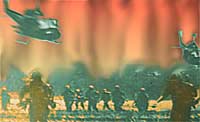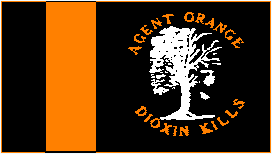
AGENT ORANGE FACT AND LINKS PAGE

What is Agent Orange?
Agent Orange was an herbicide employed during the Second Indochina War commonly referred to as the Viet Nam War. Agent Orange was not the only herbicide sprayed in Vietnam although, due to its intensified usage, it is the herbicide most commonly mentioned and blamed for health problems in connection with that period in history. There were two other herbicides, an insecticide and a chemical irritant used during the Second Indochina War. They each were called by code names: Agent Blue, Agent Orange, Agent White, CS and Malathion.
Agent Blue: code name for cacodylic acid (dimethyl arsenic acid; 371.5 km/m3)
Agent Orange: code name for mixture of 2,4,5-T (2,4,5.-trichlorophenoxyacetic acid; 545.4 Kg/m3) and 2,4-D (2,4-dichlorophenoxyacetic acid; 485.1 kg/m3), altogether weighing 1 285 kg/m3; a herbicide; associated with the (2,4,5-T moiety is the impurity dioxin (2,3,7,8-tetrachlorodibenzo-p- dioxin).
Agent White: code name for a mixture of an approximate ratio of 4:1 of 2,4-D (2,4-dichlorophenoxyacetic acid; 239.7 kg/m3) and picloram (4-amino-3,5,6-trichloropicolinic acid; 64.7 kg/m3)
CS (o -chlorobenzalmalonitrile), an anti-personnel (harassing) agent, was used as an irritant from 1964 to 1970.
Malathion (S-(1,2-dicarbethoxyethyl)-0, 0-dimethyldithiophosphate), an insecticide, was sprayed from 1967 to 1972.
Agent Orange (A-O) and Agent White (A-W) contain mixtures of plant hormone mimicking compounds which destroy plants by interfering with their normal metabolism. Agent Blue (A-B) destroys vegetation by preventing plants from retaining moisture. These chemical products were used in Viet Nam during the years 1961 to 1971. The three year period from 1967 to 1969 herbicide usage was at its heaviest. A-O (61% usage) and A-W were effective against dicotyledonous plants (two leaves emerging from seed) and A-B (11% usage) was used for monocotyledonous plants (single leaf emerging from seed). A-W and A-O were used to destroy the forests of South Viet Nam while A-B was mainly used for the destruction of grain crops, particularly the staple crop of rice. The levels of usage for military operations was 20 to 40 times greater than for normal agricultural usages. These chemicals were dispensed by fixed-wing aircraft and ground troops.
Loss of foliage, flower and fruit occurred within two to three weeks after spraying. Not all of the trees died and a large percentage of those surviving trees were permanently damaged. Environmentally, because it was in a tropical area, there was an increase in soil nutrient loss and an acceleration in soil erosion. Dioxin has an environmental half life of about three years or more and has shown up in the food chain. The effect of A-O on humans has been an area of intense debate for the past two decades. It has now been thoroughly established that dioxin is a very potent poison. It can cause a wide range of organ and metabolic dysfunctions. In laboratory animals dioxin has shown to be carcinogenic (causing cancer ) and teratogenic (causing birth defects) and mutagenic (causing genetic damage).

Vietnam and Agent Orange Facts
Brief History of Agent Orange

Agent Orange Spray Map

The Veterans Administration
and Agent Orange Compensation
The Department of Veterans Affairs (formerly the Veterans Administration, and still known as the VA) currently offers service-connected compensation for certain diseases believed to be associated with Agent Orange exposure. The diseases are:
Chloracne
The VA also recognizes the following condition in the Children of Vietnam veterans, pending final regulation:
Spina bifida
![]()
Agent Orange Informational Web Page
Office of the Assistant Secretary of Defense -NEWSBRIEFING re: Agent Orange
News from the Institute of Medicine
Agent Orange Brief (prepared by the Department of Veteran's Affairs)
